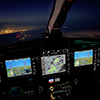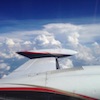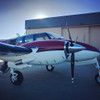12 Nov 2025, 01:53 [ UTC - 5; DST ]
|

| Username Protected |
Message |
|
Username Protected
|
Post subject: Re: real numbers from flying a Malibu last year  Posted: Posted: 04 Jan 2015, 10:53 |
|
 |

|
|
 |


Joined: 09/02/09
Posts: 8726
Post Likes: +9456
Company: OAA
Location: Oklahoma City - PWA/Calistoga KSTS
Aircraft: UMF3, UBF 2, P180 II
|
|
Username Protected wrote: Jetprops are incredibly cheap to maintain and fly. Fuel cost/nm is competitive with a piston. Owners report annual maint costs often under $10k. But you're looking at another half million capital costs, minimum. Meridians can be had cheaper but cost more to fly and maintain. Will you elaborate on this? Why is the Jetprop cheaper to fly and maintain?
|
|
| Top |
|
|
Username Protected
|
Post subject: Re: real numbers from flying a Malibu last year  Posted: Posted: 04 Jan 2015, 11:08 |
|
 |

|
|

Joined: 01/11/10
Posts: 3833
Post Likes: +4140
Location: (KADS) Dallas, TX
|
|
Username Protected wrote: Jetprops are incredibly cheap to maintain and fly. Fuel cost/nm is competitive with a piston. Owners report annual maint costs often under $10k. But you're looking at another half million capital costs, minimum. Meridians can be had cheaper but cost more to fly and maintain. Is this your experience? I have a friend that manages and flies a Jetprop. He agrees it is a very capable aircraft for the money, but he is often staggered by the cost. He takes his to a place in Kansas and the cheapest annual was $18K I believe, with many much higher. Additionally, there are always little things to deal with during the year that can be very expensive especially if they are airframe parts.
|
|
| Top |
|
|
Username Protected
|
Post subject: Re: real numbers from flying a Malibu last year  Posted: Posted: 04 Jan 2015, 11:52 |
|
 |

|
|
 |

Joined: 07/11/11
Posts: 2413
Post Likes: +2769
Location: Woodlands TX
Aircraft: C525 D1K Waco PT17
|
|
Username Protected wrote: Jetprops are incredibly cheap to maintain and fly. Fuel cost/nm is competitive with a piston. Owners report annual maint costs often under $10k. But you're looking at another half million capital costs, minimum. Meridians can be had cheaper but cost more to fly and maintain. Is this your experience? I have a friend that manages and flies a Jetprop. He agrees it is a very capable aircraft for the money, but he is often staggered by the cost. He takes his to a place in Kansas and the cheapest annual was $18K I believe, with many much higher. Additionally, there are always little things to deal with during the year that can be very expensive especially if they are airframe parts.
I would agree with Charles. In general, a turbine is a higher acquisition cost, but maintenance is lower and a lot less headaches.
|
|
| Top |
|
|
Username Protected
|
Post subject: Re: real numbers from flying a Malibu last year  Posted: Posted: 04 Jan 2015, 12:59 |
|
 |

|
|
 |

Joined: 11/08/12
Posts: 12835
Post Likes: +5276
Location: Jackson, MS (KHKS)
Aircraft: 1961 Cessna 172
|
|
Username Protected wrote:
Will you elaborate on this? Why is the Jetprop cheaper to fly and maintain?
Jetprop - Born piston (Malibu or Mirage) converted by Rocket Engineering to a PT6. Either -21, -34 or -35. Meridian - Born turboprop from factory . PT6-42 The Jetprop and Meridian stem from very different design philosophies. The Jetprop is stone simple with manual systems entirely under the pilots control, good or bad. The Meridian was designed to do as much behind the scenes as possible and is more mechanically complicated in trade for being operationally simpler. Examples: The Meridian has an automated lockout for beta and reverse in flight. Jetprop doesn't. The Meridian switches tanks automatically. The Meridian has the inertial separator door fixed open at all times - that robs power and costs a couple gph but you can't get induction icing if you forget to open it. Partially as a result of that decision, the Meridian uses a big block PT6 that is costlier to purchase, costlier to overhaul, has higher fuel burn during ground holds, and has magnesium parts that are prone to costly corrosion issues. The small block PT6 in the Jetprop is less susceptible to corrosion and gets better fuel economy. The Meridian is notably heavier and has 10% less HP. All that adds up to more fuel for a given mission. The Meridian uses more complicated systems - more stuff to break and all proprietary $$$$ parts. The meridian maintenance/SB schedule offers some potentially pricey stuff. (Battery replacement every two years at a few AMU.) While not strictly mandatory, you get penalized in the resale market if you haven't followed it. Not sure if this is still true with planes well over 10 years old but it is with newer ones. Of course, you're looking at six-figure annual depreciation with a newer Meridian so $5K here and there may not be a big issue.
|
|
| Top |
|
|
Username Protected
|
Post subject: Re: real numbers from flying a Malibu last year  Posted: Posted: 04 Jan 2015, 14:40 |
|
 |

|
|
 |

Joined: 12/19/08
Posts: 12160
Post Likes: +3545
Aircraft: C55
|
|
Username Protected wrote: There was one posted recently that had over 100 pound negative payload with full fuel. Basically you couldn't legally fill it. Seems crazy I thought the pt6 was about the same weight, is the weight in the PSRU? Just seems like if you're going to bite off 45-50k a year to operate a Malibu you might just consider going turbine for not much more, especially with the jetA advantages and turbine reliability. The Jet Prop will cost you at least 2x more investment, 3x the insurance, and have less useful load. It makes no sense to me.
_________________
The kid gets it all. Just plant us in the damn garden, next to the stupid lion.
|
|
| Top |
|
|
Username Protected
|
Post subject: Re: real numbers from flying a Malibu last year  Posted: Posted: 04 Jan 2015, 16:07 |
|
 |

|
|
 |

Joined: 07/11/11
Posts: 2413
Post Likes: +2769
Location: Woodlands TX
Aircraft: C525 D1K Waco PT17
|
|
Username Protected wrote: There was one posted recently that had over 100 pound negative payload with full fuel. Basically you couldn't legally fill it. Seems crazy I thought the pt6 was about the same weight, is the weight in the PSRU? Just seems like if you're going to bite off 45-50k a year to operate a Malibu you might just consider going turbine for not much more, especially with the jetA advantages and turbine reliability. The Jet Prop will cost you at least 2x more investment, 3x the insurance, and have less useful load. It makes no sense to me.
The jet prop will cost 2x the investment but will definitely not cost 3x the insurance - I don't know where you get this info. It will also carry slightly more UL than the meager UL of the Malibu - the weight limitations of the jet prop are specific to the airframe (PA46 just doesn't carry much). In fact, the turbine is much lighter than the Lycoming.
And - it will be significantly cheaper to maintain compared to the Malubu. The Lycoming will self destruct before reaching TBO and you will continuously need to be messing with it.
You won't need to do much to the turbine except for a HS mid way through its 3600 hr life, and if you care for it, it will be a 30K event at most.
The cost of a JetProp will be about the same on a per hour basis vs the Malibu but lower on a per mile basis which is what counts anyway.
|
|
| Top |
|
|
Username Protected
|
Post subject: Re: real numbers from flying a Malibu last year  Posted: Posted: 04 Jan 2015, 17:20 |
|
 |

|
|

Joined: 07/17/10
Posts: 211
Post Likes: +40
Location: CA
|
|
|
Don't forget to add property tax
|
|
| Top |
|
|
Username Protected
|
Post subject: Re: real numbers from flying a Malibu last year  Posted: Posted: 04 Jan 2015, 17:24 |
|
 |

|

|
 |


Joined: 06/28/09
Posts: 14423
Post Likes: +9555
Location: Walnut Creek, CA (KCCR)
Aircraft: 1962 Twin Bonanza
|
|
Also if you're not going to self insure, without malibu time you're probably looking at 10k+ Also, where are the 200k Malibu's? If going piston I'd go with a 550... Quote: The euphoria over the Malibu proved short-lived. Scores of engine failures were blamed on the Continental engine. The 520s used in Malibus held just eight quarts of oil, or four quarts less than many other variants of the same engine. This, plus poor flows of engine intake and exhaust air, the absence of cowl flaps, and a fundamental misjudgment of piston-engine thermal stresses at altitude were blamed for many problems — with hot-running cylinders leading the list. As time wore on, more problems surfaced. Starter and air conditioner drives, and over-torqued crankcase through-bolts, caused more engine failures.
Many felt that the published leaning procedures explained at least some of the Continental's problems. Because of the engine's tuned induction system, Piper advised leaning to 50 degrees lean of peak turbine inlet temperature (TIT) for all cruise power settings. Using a richer mixture, Continental said, would cause the engine to run at super-high (better than 80 percent) power settings and cause much higher-than-normal operating temperatures. There is widespread speculation that many Malibu owners operated their engines at rich-of-peak mixture settings, succumbing to habits established with more conventional engines.
There were other service problems. Among them was the hydraulic system, which lacked an accumulator and thus produced pressure spikes that blew O-rings. Low fluid levels would cause the pump to fail. In addition, the hydraulically actuated flaps needed their linkages periodically adjusted.
A spate of wrist pin problems finally prompted Piper to ground the early Malibu fleet in November 1987. In a grandiose act, Piper's then-president M. Stuart Millar promised first-class airline travel to all inconvenienced Malibu owners. On a superficial level, this was perceived as an act of magnanimity. In reality, this gesture was a symptom of the growing financial irresponsibility that would eventually bring Piper to bankruptcy.
Despite a number of fixes intended to keep the Continental from running hot and falling apart, the -BE had been tarred, and the early Malibu with it. For this reason, some Malibu owners have opted for a recent STC that allows the installation of the cooler-running, more powerful Continental TSIO-550C. Though it's capable of 350 hp, the -550C is derated to 310 hp for the Malibu.
_________________
http://calipilot.com
atp/cfii
|
|
| Top |
|
|
Username Protected
|
Post subject: Re: real numbers from flying a Malibu last year  Posted: Posted: 04 Jan 2015, 17:24 |
|
 |

|
|

Joined: 07/17/10
Posts: 211
Post Likes: +40
Location: CA
|
|
|
1.25% where I live. Big difference between my 200k baron and a $2MM turboprop.
|
|
| Top |
|
|
Username Protected
|
Post subject: Re: real numbers from flying a Malibu last year  Posted: Posted: 04 Jan 2015, 18:14 |
|
 |

|
|
 |

Joined: 12/19/08
Posts: 12160
Post Likes: +3545
Aircraft: C55
|
|
Code: Also if you're not going to self insure, without malibu time you're probably looking at 10k+ I seriously doubt that. My P210 was insured for $160k and has a bad safety record along with bad gear up record. It was $2900/yr to insure and I had no P210 time. I flew it 10 hours uninsured and that gave me the time they wanted IIRC. I don't see the Malibu as being any more to insure except that the hull value might be $200-225k raising the insurance another $1000 maybe.
_________________
The kid gets it all. Just plant us in the damn garden, next to the stupid lion.
|
|
| Top |
|

|
You cannot post new topics in this forum
You cannot reply to topics in this forum
You cannot edit your posts in this forum
You cannot delete your posts in this forum
You cannot post attachments in this forum
|

Terms of Service | Forum FAQ | Contact Us
BeechTalk, LLC is the quintessential Beechcraft Owners & Pilots Group providing a
forum for the discussion of technical, practical, and entertaining issues relating to all Beech aircraft. These include
the Bonanza (both V-tail and straight-tail models), Baron, Debonair, Duke, Twin Bonanza, King Air, Sierra, Skipper, Sport, Sundowner,
Musketeer, Travel Air, Starship, Queen Air, BeechJet, and Premier lines of airplanes, turboprops, and turbojets.
BeechTalk, LLC is not affiliated or endorsed by the Beechcraft Corporation, its subsidiaries, or affiliates.
Beechcraft™, King Air™, and Travel Air™ are the registered trademarks of the Beechcraft Corporation.
Copyright© BeechTalk, LLC 2007-2025
|
|
|
|



